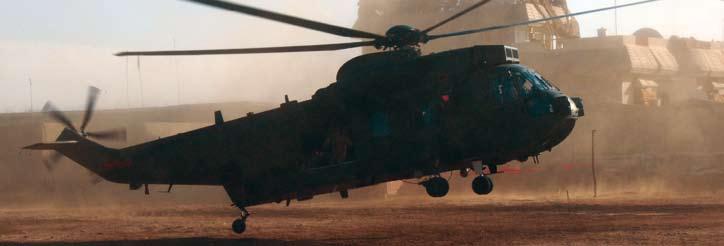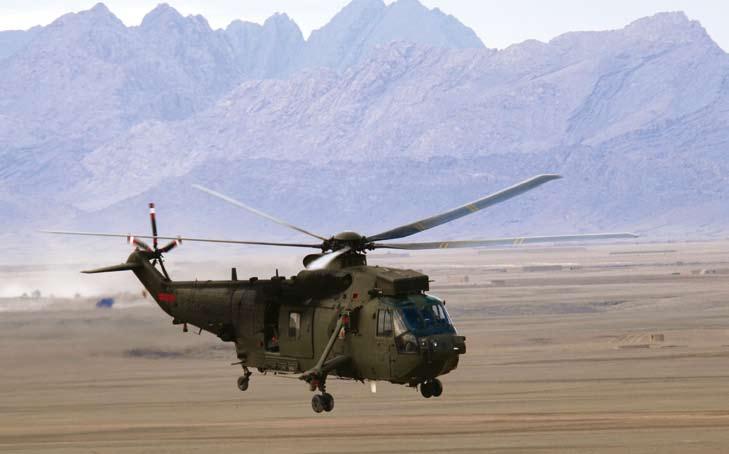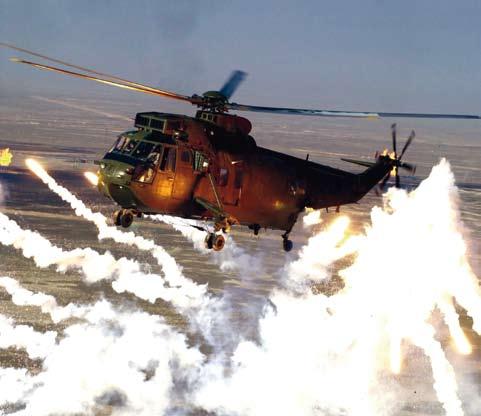
7 minute read
Royal Navy in Afghanistan
Ro yal Navy in Afg hanistan
by john darcy (2002)
“HLS is clear; beware insurgent activity to the North and East; approach from the Southwest”. The radio transmission comes from the Joint Tactical Air Controller (JTAC) in the Forward Operating Base (FOB) at which we are about to land. It is the middle of the night; still 35°C, no moon, no cultural lighting, and even with our Night Vision Goggles (NVGs) all we can see as we descend rapidly through the Afghan sky is dusty blackness. Manoeuvring the aircraft sharply in the descent, we conduct a quick landing brief taking account of the suggested landing direction combined with our need to land into wind to assist aircraft performance.
As we near ground level we are at maximum speed, the door gunner and aircrewman are manning the aircraft’s weapons and both pilots are straining to get ‘eyes on’ our landing site (LS). The aircraft commander calls out distance and direction to the LS from the GPS. “1 mile, 030°..….0.6, 025°, speed back”,
the aircraft flares significantly to decelerate in preparation for landing, “0.3, 045°”….“Visual”. The dimmed lights of the tiny FOB appear through the darkness and in the courtyard we can just make out the makeshift LS: 4 infrared (IR) chemical sticks marking a box. The aircraft commander calls out heights and speeds, the aircrewman in the back is crouched down in the doorway, his body mostly outside the aircraft as he calls out the position of the enormous dust cloud billowing up behind the aircraft, kicked up from the power of the rotor blades. In one continuous movement the aircraft is brought onto the ground, just as the ... continued
dust cloud catches up and overwhelms everything. For a moment everyone is blind, but there is no time to wait. The crewman quickly sends out the soldiers and kit we have flown in and ushers in those waiting to fly out. The pilots discuss the departure plan, given the significant threats mentioned ahead of us. After only a couple of minutes we are good to go. Speed is of the essence as an aircraft soon attracts attention, even at this time of night and we are a sitting duck. As much engine power as we have available is applied to lift the aircraft cleanly from the ground. Very quickly the dust cloud is back and everyone is blind again. Full power is held and using the aircraft instruments the helicopter is brought vertically up until the crew can see over the top of the cloud. A sharp 180° turn and we rapidly accelerate away from the danger area. There can be no dawdling as it is not uncommon to receive incoming fire. As we climb up a quick glance is thrown down the back of the aircraft to check everyone is ok. The soldiers look exhausted. “Cheers fellas,

see you soon” from the JTAC over the radio. First FOB of the night done, seven more to go. Another night during a tour of Afghanistan. Many people believe that the Royal Navy (RN) confines itself to the Seven Seas either on the surface or below it, so the phrase “Royal Navy in Afghanistan” can lead to a raised eyebrow or two. In fact this summer alone around 3,500 Naval personnel served in Afghanistan – 40% of all UK Forces deployed there. Between April and October, 3 Commando Brigade Royal Marines, the Navy’s elite amphibious infantry, had the UK lead role on the ground in Helmand Province, as they have done on previous deployments. Naval personnel also fill many medical, administrative, tactical, logistic and Command positions and Naval Air Squadrons (NAS) have maintained a continuous commitment to Afghanistan operations over the last 4 years. 1 in 5 British helicopters in Afghanistan is RN and up to 120 ground and aircrew are deployed at any one time at Camp Bastion as part of the Commando Helicopter Force (CHF) or the Airborne Surveillance and Control Squadrons. Prior to the disbandment of the Harrier GR9 aircraft following the Strategic Defence and Security Review of 2010, Naval jet pilots flew many missions in support of Coalition troops in Afghanistan. The Royal Navy therefore, has been at the forefront of Afghanistan operations for quite some time. As a pilot on 846 NAS I serve as part of CHF; a unit containing 4 flying Squadrons, a Headquarters and a complement of fully deployable support sections. CHF is highly versatile, able to operate in arctic, jungle and desert Speed is of the essence as an aircraft soon attracts attention, even at this time of night and we are a sitting duck.
conditions as well as from ships in its role as the UK’s specialist amphibious assault force. The ‘Junglies’ (a name given to the personnel within CHF following success in the jungles of Borneo in the 1960s and by which they are still known) are highly committed not only in Afghanistan but also on multinational exercises or amphibious operations that take place, including standing by to support NATO efforts off Libya earlier this year.
The Sea King Mk 4 helicopter has been at the forefront of Commando aviation since the Falklands War. Able to operate in all weather by day and night it can carry troops and internal cargo or heavy loads slung underneath the aircraft. Designed to conduct amphibious operations from ships, the bulk of the operational work in recent years has been in the deserts of Iraq and Afghanistan. On operations we ‘Junglies’ are largely found low over the Green Zone in Helmand Province, moving troops and equipment between the FOBs or dropping off heavy loads. Our training means we are not limited to any one particular task and we support the troops in any way we can. We prefer to operate at night, when temperatures are cooler and we have the added protection of darkness. The absence of cultural lighting in Helmand means the nights are exceptionally dark and with little or no moon it is only possible to see the ground from 100 feet and often less, even with NVGs. This can prove challenging when approaching small, dusty landing sites in high threat areas. It is in such conditions that the ‘Junglies’ have made their name by routinely conducting such operations night after night. We use Display Night Vision Goggles (DNVG), which provide us with flight and navigational data via a monocle fitted to our NVGs. This enables us to see relevant information during flight without us having to look at cockpit instrumentation. Each landing is conducted in accordance with our specific ‘dust’ technique, in which we maintain a visual reference with the ground as we land even as the aircraft becomes engulfed in sand. By not doing so one can lose positional awareness, which is dangerous. Slick crew co-operation within the aircraft is crucial; there is no room for complacency especially since a crew can be in the aircraft for several hours at a time in demanding conditions. However, combining hard work with humour and friendly banter is common throughout the military and the ‘Junglies’ are no exception.
The demanding Afghan environment takes its toll on the aircraft and one is constantly operating the helicopters on the edge of their performance envelopes. The extreme summer heat, the high terrain and the harsh flight manoeuvres that are required on each sortie all ask a lot of the aircraft. The engineers work very hard to ensure the aircraft stay operationally effective and so, in spite of its age, the Sea King constantly proves its worth as a reliable multi-role platform. The ‘Whys and Wherefores’ of Coalition tasks in Afghanistan can be a complex subject and each member of the team holds their own opinion. However ideological debate is left aside in the aircraft, when everyone focuses solely on our primary and crucial role: supporting the troops. Every member of CHF works at the top of their professional game to preserve life and equipment each day so that our support can continue. My 3 tours of Afghanistan so far have been both rewarding and challenging. Reward comes from working hard to help support the troops who carry out dangerous tasks in difficult conditions every day. The challenges come from operating in high threat areas in which rotary aviation assets are frequently targeted and also from the potential dangers that can arise from flying in inhospitable environmental conditions. I can say with certainty that so far I have enjoyed my time on the front line and am very proud to serve with my fellow ‘Junglies’ as part of CHF and the Royal Navy’s Fleet Air Arm.





